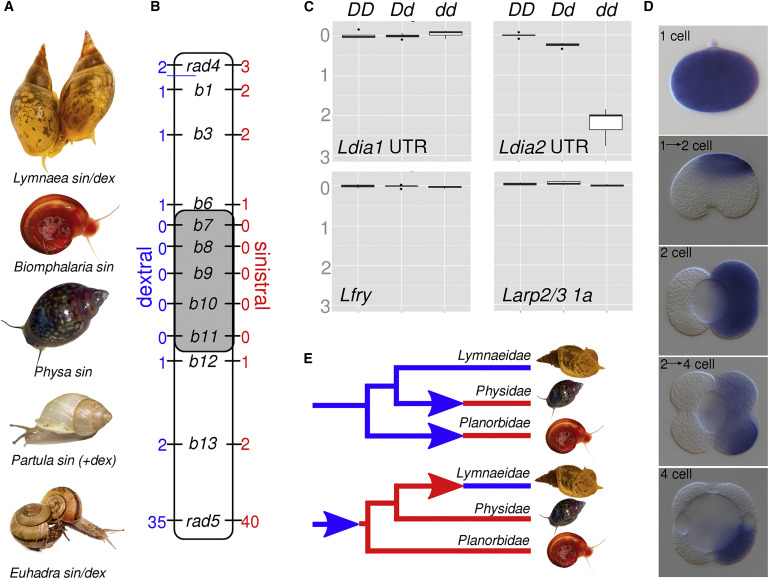|
|||||||||||||||
|

CLICK ON weeks 0 - 40 and follow along every 2 weeks of fetal development
|
|||||||||||||||||||||||||||
Snail shells help solve origins of body symmetry Published in the journal Current Biology, the research was led by Angus Davison PhD, an expert in evolutionary genetics in the School of Life Sciences at The University of Nottingham, United Kingdom (UK). Finding this gene is an important step in understanding how our own organs develop within our bodies, sometimes reversed or sometimes in mirrored placement. Davison led an international research project with scientists from the University of Edinburgh, UK, the University of Göttingen, Germany, and Tufts University in the USA. Using snails, Davison and colleagues were able to identify a gene that controls whether a snail shell twists clockwise or counter-clockwise. The gene makes the protein "formin," and a defect in "formin" means the whole snail is "reversed," and becomes a mirror image of others of its' same species.
The scientists first mapped the location of the gene that defines mirror image development in snails, then used genome sequencing technologies to find the mutation in the formin gene that makes snails develop a counter-clockwise coiling — or mirror image. Professor Mark Blaxter, leader of the genome sequencing effort in Edinburgh, UK: "We were able to use cutting-edge DNA sequencing and computer analyses to not only sequence the genome of the pond snail very rapidly, but this enabled Angus to identify the tiny change (one letter in the one billion of the snails' genome) that causes the switch from clockwise to anti-clockwise. The combination of traditional genetics and developmental biology with these new genomics tools has delivered stunning results."
Dan Jackson PhD, University of Göttingen, Germany: "Contrary to what we expected, we were surprised to find asymmetry is present in the very early embryo — from the two-cell stage onwards. By seeing the active asymmetry resulting from the formin gene in these early embryos, we now had stunning supporting evidence for the role of the formin gene in this evolutionarily ancient process." To understand if there was a link to human development, collaborating scientists in the US experimented with the frog to successfully show the formin gene has a similar function in the early development of all vertebrates (animals with backbones). The researchers believe their work provides strong evidence that this same molecule is likely to be among the earliest 'symmetry breaking' components across all Bilateria — or animals with one central axis of symmetry. Both snail and frog embryos derive asymmetry from formin influenced events inside cells at very early stages of development.
Dr Angus Davison added: "The 'switch' from clockwise to counter-clockwise snails is one of the earliest inherited markers to be properly described in the 1920s, but the identity of the gene involved has been unknown ever since. While living in Japan in 2001, I noticed that snails around me were 'wrongly' counter-clockwise coiled. Ever since, I have wanted to find the gene. After securing funding from the BBSRC, we used new DNA sequencing technologies to find the gene — it took only three and a half years. Abstract Results and Discussion Given the importance of chiral patterning in the three bilaterian superphyla, Deuterostomia, Ecdysozoa, and Lophotrochozoa, a continuing problem is a lack of knowledge of the first symmetry-breaking steps in the Lophotrochozoa, even though the first described locus that reverses the whole body structure of an animal was from the pond snail Lymnaea [10, 11]. Recently, commonalities between different species have been discovered [12, 13, 14, 15]. For example, in both vertebrates (Deuterostomia) and snails (Lophotrochozoa), nodal and pitx encode key signaling molecules required for the establishment of LR asymmetry, suggesting that these genes may have been used in the last common ancestor of Bilateria, but lost in Ecdysozoa [1, 2, 16]. However, neither nodal nor pitx is the earliest symmetry-breaking determinant in snails, ultimately limiting a knowledge of whether this represents deep conservation or convergent use of the same genes. Within Lophotrochozoa, snails are unique in that they exhibit genetically tractable, natural variation in chirality [17] and so may aid in understanding of the establishment and conservation of LR asymmetry. Here, we use genetics, genomics, and pharmacological inhibition to show that the Lymnaea stagnalis chirality gene is a scaffolding component of the cytoskeleton. We present strong evidence that this same molecule is one component of an early chiral cytoskeletal structure that is involved in the earliest symmetry-breaking steps across the Bilateria. |
Mar 4, 2016 Fetal Timeline Maternal Timeline News News Archive 
Asymmetry is present in the very early embryo — from the two-cell stage onwards.
|
|||||||||||||||||||||||||||

